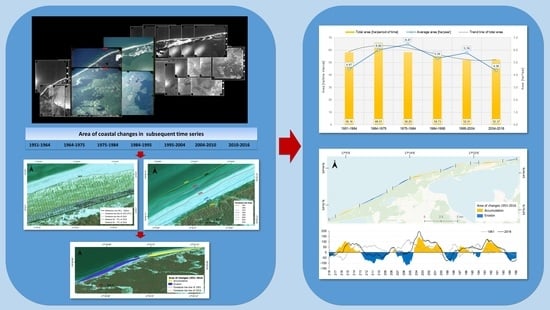Multi-Temporal Analysis of Changes of the Southern Part of the Baltic Sea Coast Using Aerial Remote Sensing Data
Abstract
1. Introduction
- to calculate the area of coastal zone changes (erosion/accumulation) in each decade.
- to determine the spatial and temporal distribution of changes.
- to attempt to identify the main factors causing those changes.
2. Materials and Methods
2.1. Study Area
2.2. Data
2.3. Processing of Aerial Data
2.4. Analysis of Changes in the Baltic Coastal Zone
- -
- ATY—average area for a period of time
- -
- AT—total area in the time period
- -
- a—partial area in the time period
- -
- T—period of time
- -
- n—number of years
3. Results
3.1. Analysis of the Areas Eroded and Accumulated in the Examined Period
Balance of the Impact of Morphodynamic Processes on the Studied Part of the Coast
4. Discussion
5. Conclusions
Author Contributions
Funding
Institutional Review Board Statement
Informed Consent Statement
Data Availability Statement
Conflicts of Interest
References
- Brown, A.G.; Tooth, S.; Bullard, J.E.; Thomas, D.S.G.; Chiverrell, R.C.; Plater, A.J.; Murton, J.; Thorndycraft, V.R.; Tarolli, P.; Rose, J.; et al. The geomorphology of the Anthropocene: Emergence, status and implications. Earth Surf. Process. Landf. 2017, 42, 71–90. [Google Scholar] [CrossRef]
- Stive, M.J.; Aarninkhof, S.G.; Hamm, L.; Hanson, H.; Larson, M.; Wijnberg, K.M.; Nicholls, R.J.; Capobianco, M. Variability of shore and shoreline evolution. Coast. Eng. 2002, 47, 211–235. [Google Scholar] [CrossRef]
- Suursaar, Ü.; Kullas, T.; Otsmann, M.; Kõuts, T. Extreme sea level events in the coastal waters of western Estonia. J. Sea Res. 2003, 49, 295–303. [Google Scholar] [CrossRef]
- Manca, E.; Pascucci, V.; Deluca, M.; Cossu, A.; Andreucci, S. Shoreline evolution related to coastal development of a managed beach in Alghero, Sardinia, Italy. Ocean Coast. Manag. 2013, 85, 65–76. [Google Scholar] [CrossRef]
- Pradhan, B.; Rizeei, H.M.; Abdulle, A. Quantitative assessment for detection and monitoring of coastline dynamics with temporal RADARSAT images. Remote Sens. 2018, 10, 1705. [Google Scholar] [CrossRef]
- Chaaban, F.; Darwishe, H.; Louche, B.; Battiau-Queney, Y.; Masson, E.; Khattabi, J.E.; Carlier, E. Geographical information system approach for environmental management in coastal area (Hardelot-Plage, France). Environ. Earth Sci. 2011, 65, 183–193. [Google Scholar] [CrossRef]
- Natesan, U.; Parthasarathy, A.; Vishnunath, R.; Kumar, G.E.J.; Ferrer, V.A. Monitoring Longterm Shoreline Changes along Tamil Nadu, India Using Geospatial Techniques. Aquat. Procedia 2015, 4, 325–332. [Google Scholar] [CrossRef]
- Mukhopadhyay, A.; Mukherjee, S.; Mukherjee, S.; Ghosh, S.; Hazra, S.; Mitra, D. Automatic shoreline detection and future prediction: A case study on Puri coast, Bay of Bengal, India. Eur. J. Remote Sens. 2012, 45, 201–213. [Google Scholar] [CrossRef]
- Al Fugura, A.; Billa, L.; Pradhan, B. Semi-automated procedures for shoreline extraction using single RADARSAT-1 SAR image. Estuar. Coast. Shelf Sci. 2011, 95, 395–400. [Google Scholar] [CrossRef]
- Liu, H.; Jezek, K.C. Automated extraction of coastline from satellite imagery by integrating Canny edge detection and locally adaptive thresholding methods. Int. J. Remote Sens. 2004, 25, 937–958. [Google Scholar] [CrossRef]
- Nassar, K.; Mahmod, W.E.; Fath, H.; Masria, A.; Nadaoka, K.; Negm, A. Shoreline change detection using DSAS technique: Case of North Sinai coast, Egypt. Mar. Georesour. Geotechnol. 2018, 37, 81–95. [Google Scholar] [CrossRef]
- Oyedotun, T.D.T.; Ruiz-Luna, A.; Navarro-Hernández, A.G. Contemporary shoreline changes and consequences at a tropical coastal domain. Geol. Ecol. Landsc. 2018, 2, 104–114. [Google Scholar] [CrossRef]
- Dunn, R.A.; Genz, A.S.; Fletcher, C.H.; Frazer, L.N.; Rooney, J.J. The Predictive Accuracy of Shoreline Change Rate Methods and Alongshore Beach Variation on Maui, Hawaii. J. Coast. Res. 2007, 231, 87–105. [Google Scholar] [CrossRef]
- Angnuureng, D.B.; Almar, R.; Senechal, N.; Castelle, B.; Addo, K.A.; Marieu, V.; Ranasinghe, R. Shoreline resilience to individual storms and storm clusters on a meso-macrotidal barred beach. Geomorphology 2017, 290, 265–276. [Google Scholar] [CrossRef]
- Jiménez, J.A.; Sancho-García, A.; Bosom, E.; Valdemoro, H.I.; Guillén, J. Storm-induced damages along the Catalan coast (NW Mediterranean) during the period 1958–2008. Geomorphology 2012, 143, 24–33. [Google Scholar] [CrossRef]
- Sallenger, A.H.; Stockdon, H.F.; Fauver, L.; Hansen, M.; Thompson, D.; Wright, C.W.; Lillycrop, J. Hurricanes 2004: An overview of their characteristics and coastal change. Estuaries Coasts 2006, 29, 880–888. [Google Scholar] [CrossRef]
- Sherman, D.J.; Hales, B.U.; Potts, M.K.; Ellis, J.T.; Liu, H.; Houser, C. Impacts of Hurricane Ike on the beaches of the Bolivar Peninsula, TX, USA. Geomorphology 2013, 199, 62–81. [Google Scholar] [CrossRef]
- Zhang, K.; Douglas, B.; Leatherman, S. Do Storms Cause Long-Term Beach Erosion along the U.S. East Barrier Coast? J. Geol. 2002, 110, 493–502. [Google Scholar] [CrossRef]
- Reeve, D.E.; Fleming, C.A. A statistical-dynamical method for predicting long term coastal evolution. Coast. Eng. 1997, 30, 259–280. [Google Scholar] [CrossRef]
- Langley, S.K.; Alexander, C.R.; Bush, D.M.; Jackson, C.W. Modernizing Shoreline Change Analysis in Georgia Using Topographic Survey Sheets in a GIS Environment. J. Coast. Res. 2003, 38, 168–177. [Google Scholar]
- Łabuz, T.A. Erosion and its rate on an accumulative Polish dune coast: The effects of the January 2012 storm surge. Oceanologia 2014, 56, 307–326. [Google Scholar] [CrossRef]
- Harley, M.D.; Turner, I.L.; Short, A.D.; Ranasinghe, R. Assessment and integration of conventional, RTK-GPS and image-derived beach survey methods for daily to decadal coastal monitoring. Coast. Eng. 2011, 58, 194–205. [Google Scholar] [CrossRef]
- Gonçalves, J.A.; Henriques, R. UAV photogrammetry for topographic monitoring of coastal areas. ISPRS J. Photogramm. Remote Sens. 2015, 104, 101–111. [Google Scholar] [CrossRef]
- Casella, E.; Rovere, A.; Pedroncini, A.; Stark, C.P.; Casella, M.; Ferrari, M.; Firpo, M. Drones as tools for monitoring beach topography changes in the Ligurian Sea (NW Mediterranean). Geo-Mar. Lett. 2016, 36, 151–163. [Google Scholar] [CrossRef]
- Barlow, J.; Gilham, J.; Ibarra Cofrã, I. Kinematic analysis of sea cliff stability using UAV photogrammetry. Int. J. Remote Sens. 2017, 38, 2464–2479. [Google Scholar] [CrossRef]
- Talavera, L.; Del Río, L.; Benavente, J.; Barbero, L.; López-Ramírez, J.A. UAS as tools for rapid detection of storm-induced morphodynamic changes at Camposoto beach, SW Spain. Int. J. Remote Sens. 2018, 39, 5550–5567. [Google Scholar] [CrossRef]
- Fabbri, S.; Grottoli, E.; Armaroli, C.; Ciavola, P. Using high-spatial resolution UAV-derived data to evaluate vegetation and geomorphological changes on a dune field involved in a restoration endeavour. Remote Sens. 2021, 13, 1987. [Google Scholar] [CrossRef]
- Priest, G.R. Coastal Shoreline Change Study Northern and Central Lincoln County, Oregon. J. Coast. Res. 1999, 28, 140–157. [Google Scholar]
- Duo, E.; Fabbri, S.; Grottoli, E.; Ciavola, P. Uncertainty of Drone-Derived DEMs and Significance of Detected Morphodynamics in Artificially Scraped Dunes. Remote Sens. 2021, 13, 1823. [Google Scholar] [CrossRef]
- Fisher, J.S.; Overton, M.F. Interpretation of Shoreline Position from Aerial Photographs. In Proceedings of the 24th International Conference on Coastal Engineering, Kobe, Japan, 23–28 October 1994. [Google Scholar]
- Fletcher, C.; Richmond, B.; Rooney, J.; Barbee, M.; Lim, S.C. Mapping Shoreline Change Using Digital Orthophotogrammetry on Maui, Hawaii. J. Coast. Res. 2003, 38, 106–124. [Google Scholar]
- Ford, M. Shoreline changes interpreted from multi-temporal aerial photographs and high resolution satellite images: Wotje Atoll, Marshall Islands. Remote Sens. Environ. 2013, 135, 130–140. [Google Scholar] [CrossRef]
- Novikova, A.; Belova, N.; Baranskaya, A.; Aleksyutina, D.; Maslakov, A.; Zelenin, E.; Shabanova, N.; Ogorodov, S. Dynamics of permafrost coasts of Baydaratskaya Bay (Kara Sea) based on multi-temporal remote sensing data. Remote Sens. 2018, 10, 1481. [Google Scholar] [CrossRef]
- Gairin, E.; Collin, A.; James, D.; Maueau, T.; Roncin, Y.; Lefort, L.; Dolique, F.; Jeanson, M.; Lecchini, D. Spatiotemporal Trends of Bora Bora’s Shoreline Classification and Movement Using High-Resolution Imagery from 1955 to 2019. Remote Sens. 2021, 13, 4692. [Google Scholar] [CrossRef]
- Pardo-Pascual, J.E.; Sánchez-García, E.; Almonacid-Caballer, J.; Palomar-Vázquez, J.M.; Priego de los Santos, E.; Fernández-Sarría, A.; Balaguer-Beser, Á. Assessing the accuracy of automatically extracted shorelines on microtidal beaches from landsat 7, landsat 8 and sentinel-2 imagery. Remote Sens. 2018, 10, 326. [Google Scholar] [CrossRef]
- Maglione, P.; Parente, C.; Vallario, A. Coastline extraction using high resolution WorldView-2 satellite imagery. Eur. J. Remote Sens. 2014, 47, 685–699. [Google Scholar] [CrossRef]
- Sekovski, I.; Stecchi, F.; Mancini, F.; Del Rio, L. Image classification methods applied to shoreline extraction on very high-resolution multispectral imagery. Int. J. Remote Sens. 2014, 35, 3556–3578. [Google Scholar] [CrossRef]
- García-Rubio, G.; Huntley, D.; Russell, P. Evaluating shoreline identification using optical satellite images. Mar. Geol. 2015, 359, 96–105. [Google Scholar] [CrossRef]
- Bini, M.; Casarosa, N.; Luppichini, M. Exploring the relationship between river discharge and coastal erosion: An integrated approach applied to the Pisa coastal plain (Italy). Remote Sens. 2021, 13, 226. [Google Scholar] [CrossRef]
- Turner, I.L.; Harley, M.D.; Almar, R.; Bergsma, E.W.J. Satellite optical imagery in Coastal Engineering. Coast. Eng. 2021, 167, 103919. [Google Scholar] [CrossRef]
- Bishop-Taylor, R.; Nanson, R.; Sagar, S.; Lymburner, L. Mapping Australia’s dynamic coastline at mean sea level using three decades of Landsat imagery. Remote Sens. Environ. 2021, 267, 112734. [Google Scholar] [CrossRef]
- Castelle, B.; Masselink, G.; Scott, T.; Stokes, C.; Konstantinou, A.; Marieu, V.; Bujan, S. Satellite-derived shoreline detection at a high-energy meso-macrotidal beach. Geomorphology 2021, 383, 107707. [Google Scholar] [CrossRef]
- White, S.A.; Wang, Y. Utilizing DEMs derived from LIDAR data to analyze morphologic change in the North Carolina coastline. Remote Sens. Environ. 2003, 85, 39–47. [Google Scholar] [CrossRef]
- Shrestha, R.L.; Carter, W.E.; Sartori, M.; Luzum, B.J.; Slatton, K.C. Airborne Laser Swath Mapping: Quantifying changes in sandy beaches over time scales of weeks to years. ISPRS J. Photogramm. Remote Sens. 2005, 59, 222–232. [Google Scholar] [CrossRef]
- Hobbs, P.; Gibson, A.; Jones, L.; Poulton, C.; Jenkins, G.; Pearson, S.; Freeborough, K. Monitoring coastal change using terrestrial LiDAR. Geol. Soc. Lond. Spec. Publ. 2010, 345, 117–127. [Google Scholar] [CrossRef]
- Kuhn, D.; Prüfer, S. Coastal cliff monitoring and analysis of mass wasting processes with the application of terrestrial laser scanning: A case study of Rügen, Germany. Geomorphology 2014, 213, 153–165. [Google Scholar] [CrossRef]
- Pye, K.; Blott, S.J. Assessment of beach and dune erosion and accretion using LiDAR: Impact of the stormy 2013-14 winter and longer term trends on the Sefton Coast, UK. Geomorphology 2016, 266, 146–167. [Google Scholar] [CrossRef]
- Fuse, T.; Ohkura, T. Development of shoreline extraction method based on spatial pattern analysis of satellite SAR images. Remote Sens. 2018, 10, 1361. [Google Scholar] [CrossRef]
- Loiotine, L.; Andriani, G.F.; Jaboyedoff, M.; Parise, M.; Derron, M.H. Comparison of remote sensing techniques for geostructural analysis and cliff monitoring in coastal areas of high tourist attraction: The case study of polignano a mare (southern Italy). Remote Sens. 2021, 13, 5045. [Google Scholar] [CrossRef]
- Toure, S.; Diop, O.; Kpalma, K.; Maiga, A. Shoreline Detection using Optical Remote Sensing: A Review. ISPRS Int. J. Geo-Inf. 2019, 8, 75. [Google Scholar] [CrossRef]
- De Sanjosé Blasco, J.J.; Gómez-Lende, M.; Sánchez-Fernández, M.; Serrano-Cañadas, E. Monitoring retreat of coastal sandy systems using geomatics techniques: Somo Beach (Cantabrian Coast, Spain, 1875–2017). Remote Sens. 2018, 10, 1500. [Google Scholar] [CrossRef]
- Furmańczyk, K.; Dudzinska-Nowak, J. Przewidywanie wielkości erozji brzegu w rejonie miejscowości Trzęsacz [The prediction of shoreline erosion in the area of Trzęsacz]. In Zintegrowane Zarzadzanie Obszarami Przybrzeznymi w Polsce—Stan Obecny i Perspektywy. Morze—Lad Wzajemne Relacje; Uniwersytet Szczeciński: Szczecin, Poland, 2006. [Google Scholar]
- Furmanczyk, K.; Musielak, S.; Prajs, J. Remote sensing characteristics of dynamics of Hel’s Penisula fragment of shore line. In Proceedings of the 11th EARSel Symposium, Graz, Austria, 1–5 July 1991; pp. 208–215. [Google Scholar]
- Leatherman, S.P. Shoreline Change Mapping and Management Along the U.S. East Coast. J. Coast. Res. 2003, 38, 5–13. [Google Scholar]
- Coyne, A.M.A.; Fletcher, C.H.; Richmond, B.M. Mapping Coastal Erosion Hazard Areas in Hawaii: Observations and Errors. J. Coast. Res. 1999, 28, 171–184. [Google Scholar] [CrossRef]
- Orviku, K.; Jaagus, J.; Kont, A.; Ratas, U.; Rivis, R. Increasing activity of coastal processes associated with climate change in Estonia. J. Coast. Res. 2003, 19, 364–375. [Google Scholar]
- Dailidiené, I.; Davuliené, L.; Tilickis, B.; Stankevičius, A.; Myrberg, K. Sea level variability at the Lithuanian coast of the Baltic Sea. Boreal Environ. Res. 2006, 11, 109–121. [Google Scholar]
- Reis, H.Ç.; Bozkurt, S.; Bayram, B.; Oğurlu, M.; Şeker, D.Z.; Janpaule, I. Shoreline Extraction and Change Detection using 1:5000 Scale Orthophoto Maps: A Case Study of Latvia-Riga. Int. J. Environ. Geoinformatics 2018, 2, 1–6. [Google Scholar] [CrossRef]
- Samuelsson, M.; Stigebrandt, A. Main characteristics of the long-term sea level variability in the Baltic sea. Tellus Ser. A Dyn. Meteorol. Oceanogr. 1996, 48, 672–683. [Google Scholar] [CrossRef]
- Ryabchuk, D.; Kolesov, A.; Chubarenko, B.; Spiridonov, M.; Kurennoy, D.; Soomere, T. Coastal erosion processes in the eastern Gulf of Finland and their links with geological and hydrometeorological factors. Boreal Environ. Res. 2011, 16, 117–137. [Google Scholar]
- Ato Armah, F. GIS-based Assessment of Short Term Shoreline Changes in the Coastal Erosion-Sensitive Zone of Accra, Ghana. Res. J. Environ. Sci. 2011, 5, 643–654. [Google Scholar] [CrossRef][Green Version]
- Nicholls, R.J.; Townend, I.H.; Bradbury, A.P.; Ramsbottom, D.; Day, S.A. Planning for long-term coastal change: Experiences from England and Wales. Ocean Eng. 2013, 71, 3–16. [Google Scholar] [CrossRef]
- Miszalski, J. Współczesne Procesy Eoliczne na Pobrzeżu Słowińskim. Studium Fotointerpretacyjne [Present-Day Aeolian Processes on the Slovonian Coastline. A Photointerpretation Study]; IGiPZ PAN: Warszwa, Poland, 1973. [Google Scholar]
- Borówka, R.K. Present Day Dune Processes and Dune Morphology on the Łeba Barrier, Polish Coast of the Baltic. Geogr. Ann. Ser. A Phys. Geogr. 1980, 62, 75–82. [Google Scholar] [CrossRef]
- Musielak, S. Geneza i funkcjonowanie systemu przyrodniczego morskiej strefy brzegowej [Genesis and functioning of the natural system of the marine coastal zone]. In ZZOP w Polsce—Stan Obecny i Perspektywy, Brzeg Morski Zrównoważony, cz. 2; Uniwersytet Szczeciński: Szczecin, Poland, 2006. [Google Scholar]
- Borowka, M. Przebieg procesow deflacji I akumulacji na poweierzchni nadbrzeznych walow wydmowych [Deflation and accumulation processes on the surface of coastal dune ridges]. Badania Fizjogr. Pol. Zachodnia, Ser. A Geogr. Fiz. 1979, 32, 31–48. [Google Scholar]
- Rabski, K. Mezoklimatyczne tło obszaru Słowińskiego Parku Narodowego [The mesoclimatic background of the area of the Slovinski National Park]. Park. Nar. Rezerw. Przyr. 1992, 11, 37–54. [Google Scholar]
- Przygrodzki, P.; Letkiewicz, B. Charakterystyka wezbrań sztormowych wzdłuż polskiego wybrzeża Morza Bałtyckiego [Characteristics of storm surges along the Polish coast of the Baltic Sea]. Inżynieria Morska Geotech. 2015, 3, 158–165. [Google Scholar]
- Boniecka, H.; Gajda, A.; Gawlik, W.; Marcinkowsk, T.; Olszewski, T.; Szmytkiewicz, M.; Skaja, M.; Szmytkiewicz, P.; Chrząstkowska, N.; Piotrowska, D. Monitoring i Badania Dotyczące Aktualnego Stanu Brzegu Morskiego—Ocena Skuteczności Systemów Ochrony Brzegu Morskiego Zrealizowanych w Okresie Obowiązywania Wieloletniego, Programu Ochrony Brzegów MORSKICH” [Monitoring and research Concerning the Current State of the Sea Shore—Assessment of the Effectiveness of the Sea Shore Protection Systems Relized in the Period of Validity of the Long-Term “Programme of the Protection of Sea Shores”]; IBW PAN: Gdansk, Poland, 2013. [Google Scholar]
- Scott, T.; Masselink, G.; O’Hare, T.; Saulter, A.; Poate, T.; Russell, P.; Davidson, M.; Conley, D. The extreme 2013/2014 winter storms: Beach recovery along the southwest coast of England. Mar. Geol. 2016, 382, 224–241. [Google Scholar] [CrossRef]
- Formela, K.; Marsz, A.A. Zmienność liczby dni ze sztormem nad Bałtykiem (1971–2009) [Changeability in the number of days with gale over the Baltic Sea (1971–2009)]. Pr. Stud. Geogr. 2011, 47, 189–196. [Google Scholar]
- Miętus, M. Zagrożenia Wybrzeży i Pobrzeży Południowego Bałtyku WYNIKAJĄCE ze współczesnej Zmiany Klimatu [Threats to the coasts and shores of the southern Baltic Sea from contemporary climate change]—Uniwersytet Gdański. In Krajoznawstwo Pomorskie Wobec Wyzwań Współczesności; Wrzosek, R., Ed.; PTTK: Gdansk, Poland, 2020; ISBN 978-83-957233-0-8. [Google Scholar]
- Łabuz, T.A. Polish coastal dunes-affecting factors and morphology. Landf. Anal. 2013, 22, 33–59. [Google Scholar] [CrossRef]
- Uścinowicz, G.; Kramarska, R.; Kaulbarsz, D.; Jurys, L.; Frydel, J.; Przezdziecki, P.; Jegliński, W. Baltic Sea coastal erosion; a case study from the Jastrzębia Góra region. Geologos 2014, 20, 259–268. [Google Scholar] [CrossRef]
- Wolski, T.; Wiśniewski, B. Changes of maximum sea levels at selected gauge stations on the Polish and Swedish baltic coast. Stud. Pr. Wydz. Nauk Ekon. Zarządzania 2012, 29, 209–227. [Google Scholar]
- Zawadzka-Kahlau, E. Tendencje Rozwojowe Polskich Brzegów Bałtyku Południowego [Development Tendencies of the Polish Coasts of the Southern Baltic Sea]; Gdanskie Towarzystwo Naukowe: Gdansk, Poland, 1999. [Google Scholar]
- Zawadzka-Kahlau, E. Morphodynamics of the Southern Baltic Dune Coasts; Wydawnictwo Uniwersytetu Gdanskiego: Gdansk, Poland, 2012. [Google Scholar]
- Labuz, T.A. Brzegi wydmowe polskiego wybrzeza Baltyku. Czas. Geogr. 2005, 76, 19–47. [Google Scholar]
- Dubrawski, R.; Zawadzka-Kahlau, E. Przyszłość Ochrony Polskich Brzegów Morskich [The Future of Sea Shore Protection]; Zakład Wydawnictw Naukowych Instytutu Morskiego: Gdansk, Poland, 2006. [Google Scholar]
- Łabuz, T.A.; Kowalewska-Kalkowska, H. Coastal erosion caused by the heavy storm surge of November 2004 in the southern Baltic sea. Clim. Res. 2011, 48, 93–101. [Google Scholar] [CrossRef]
- Łabuz, T.A. Coastal Response to Climatic Changes: Discussion with Emphasis on Southern Baltic Sea. Landf. Anal. 2012, 21, 43–55. [Google Scholar]
- Michalowska, K.; Glowienka, E.; Pekala, A. Spatial-Temporal Detection of Changes on the Southern Coast of the Baltic Sea Based on Multitemporal Aerial Photographs. Int. Arch. Photogramm. Remote Sens. Spat. Inf. Sci. 2016, XLI-B2, 49–53. [Google Scholar] [CrossRef]
- Zhang, W.; Schneider, R.; Kolb, J.; Teichmann, T.; Dudzinska-Nowak, J.; Harff, J.; Hanebuth, T.J.J. Land-sea interaction and morphogenesis of coastal foredunes—A modeling case study from the southern Baltic Sea coast. Coast. Eng. 2015, 99, 148–166. [Google Scholar] [CrossRef]
- Wiśniewski, B.; Wolski, T. Katalogi Wezbrań i Obniżeń Sztormowych Poziomów Morza Oraz Ekstremalne Poziomy Wód na Polskim Wybrzeżu [Catalogues of SEA level Storm Surges and Falls and Extreme Water Levels on the Polish Coast]; Wyd. Nauk. Akad. Mors.; Maritime University of Szczecin: Szczecin, Poland, 2009. [Google Scholar]
- Rotnicki, K. Problem holoceńskiej transgresji Bałtyku Południowego na wybrzeżu środkowym Polski w świetle nowych danych z obszaru Niziny Gardzieńsko-Łebskiej [Problem of the Holocene transgressions along the Polish Baltic middle coast in the light of new data from Gardno–Łeba]. In Ewolucja Geosystemów Nadmorskich Południowego Bałtyku; Bogucki Wydawnictwo Naukowe: Poznan, Poland, 1999; pp. 121–140. [Google Scholar]
- Marsz, A. Charakterystyka geomorfologiczna Mierzei Lebskiej i Niziny Gardensko-Lebskiej [Geomorphological characteristics of the Łeba Barrier and the Gardens-Lebsk Lowland]. In Materiały Konferencji Terenowej: Gleby Słowińskiego Parku Narodowego; PTGleb.: Poznan, Poland, 1975; pp. 7–25. [Google Scholar]
- Sztobryn, M.; Stigge, H.J.; Wielbińska, D.; Weidig, B.; Stanisławczyk, I.; Kańska, A.; Krzysztofik, K.; Kowalska, B.; Letkiewicz, B.; Mykita, M. Storm surges in the southern Baltic (western and central parts). Bund. Seesch. Hydrogr. Rep. 2004, 39, 74. [Google Scholar]
- Furmanczyk, K.; Dudzinska-Nowak, J. Effects of extreme storms on coastline changes: A southern Baltic example. J. Coast. Res. 2009, 56, 1637–1640. [Google Scholar]
- Harff, J.; Deng, J.; Dudzińska-Nowak, J.; Fröhle, P.; Groh, A.; Hünicke, B.; Soomere, T.; Zhang, W. What determines the change of coastlines in the baltic sea? In Coastal Research Library; Springer: Cham, Switzerland, 2017; Volume 19, pp. 15–35. [Google Scholar]
- Łabuz, T.A.; Kowalewska-Kalkowska, H. Coastal abrasion of the Świna Gate Sandbar (Pomeranian Bay coast) caused by the heavy storm surge on 15 October 2009. In Proceedings of the Storm Surges Congress 2010, Hamburg, Germany, 13–17 September 2010. [Google Scholar]
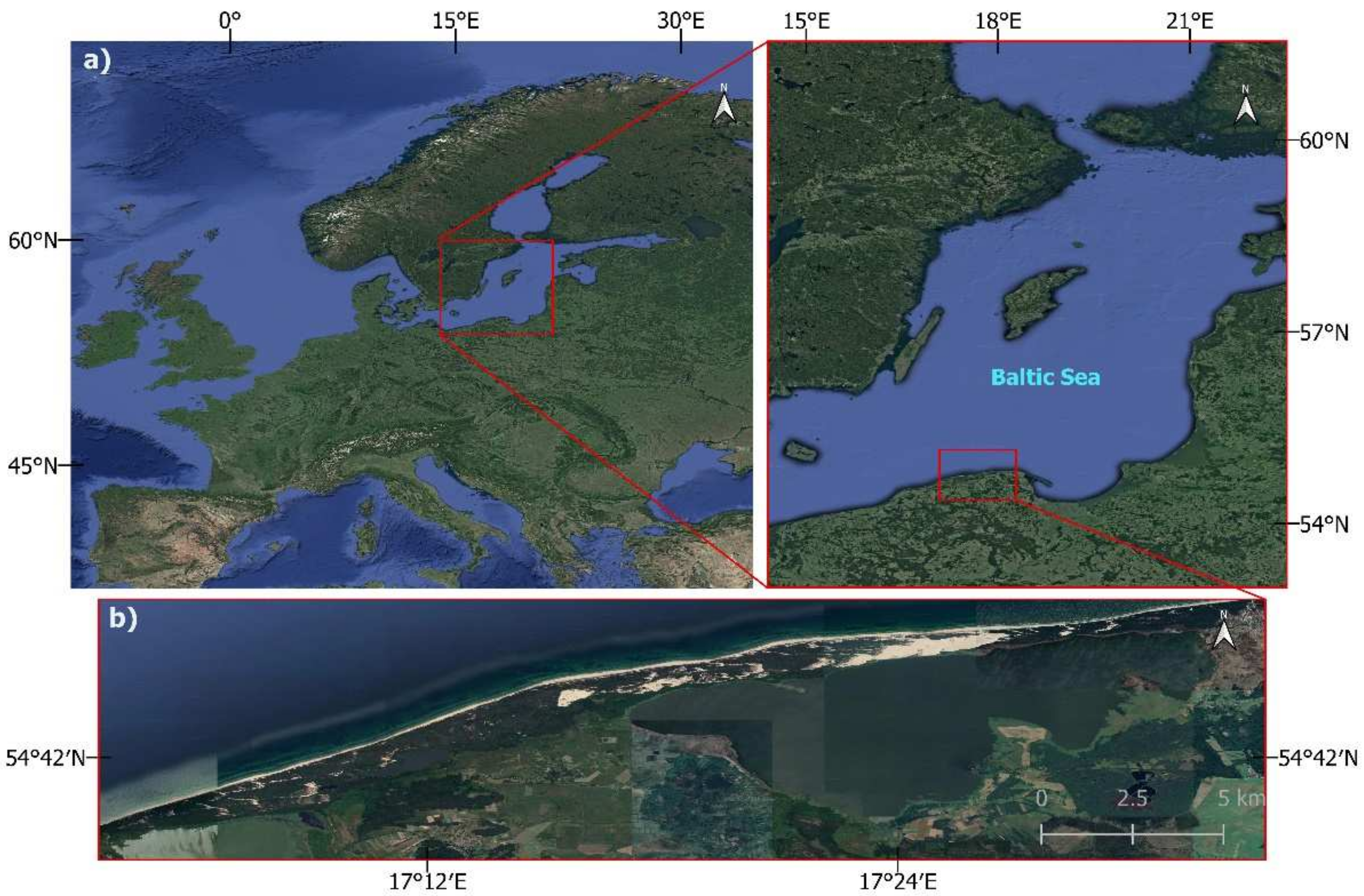

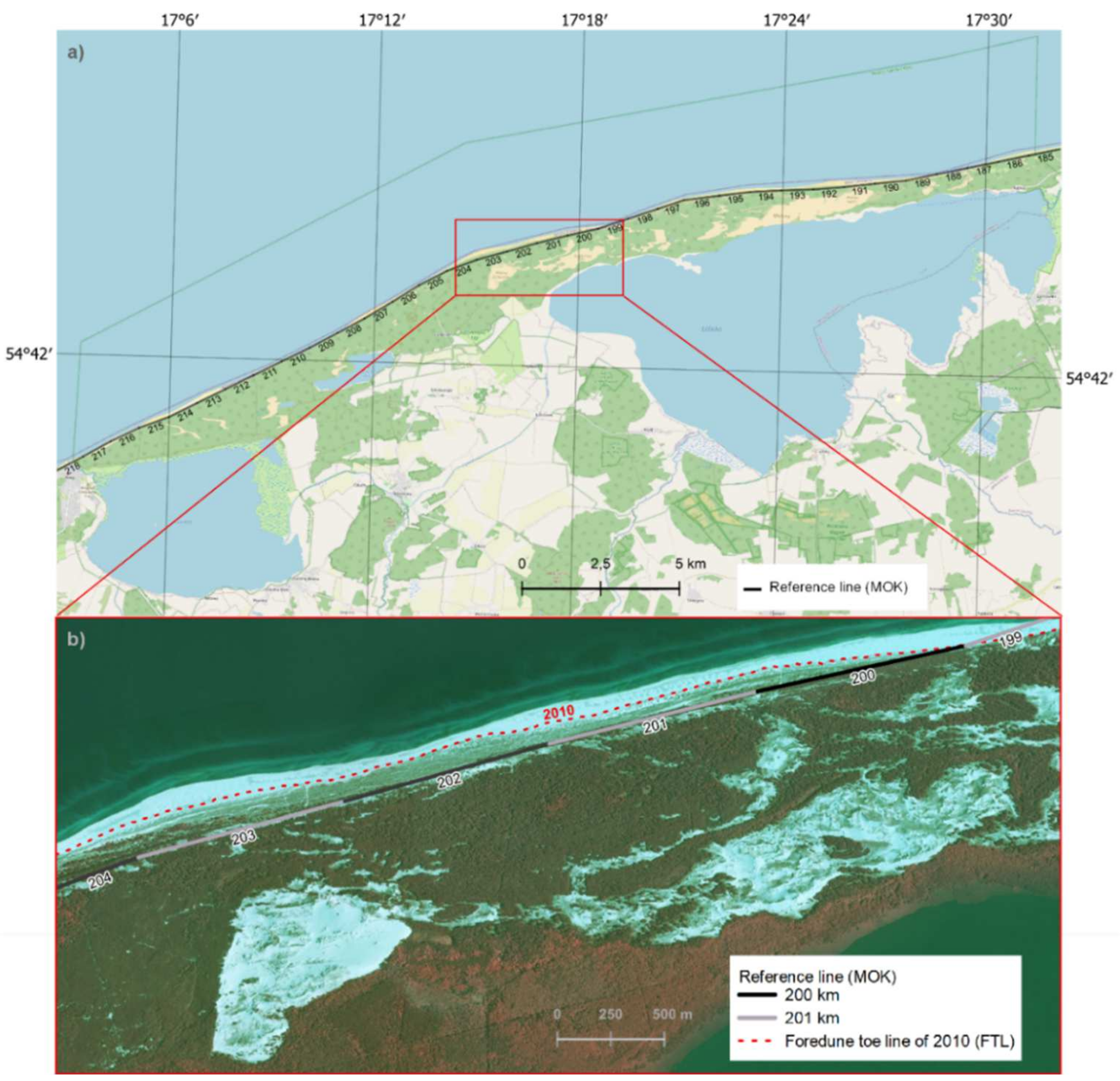
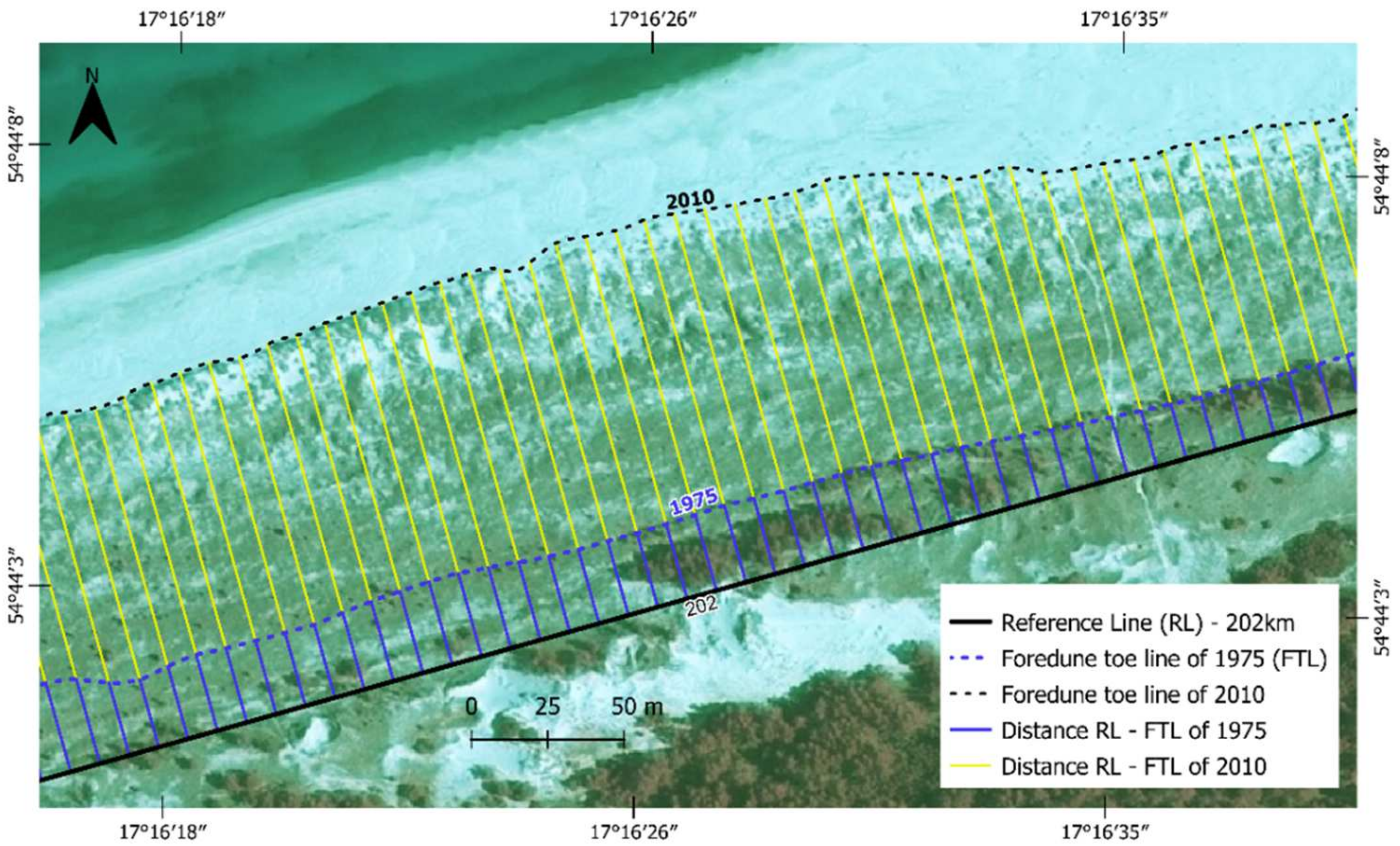
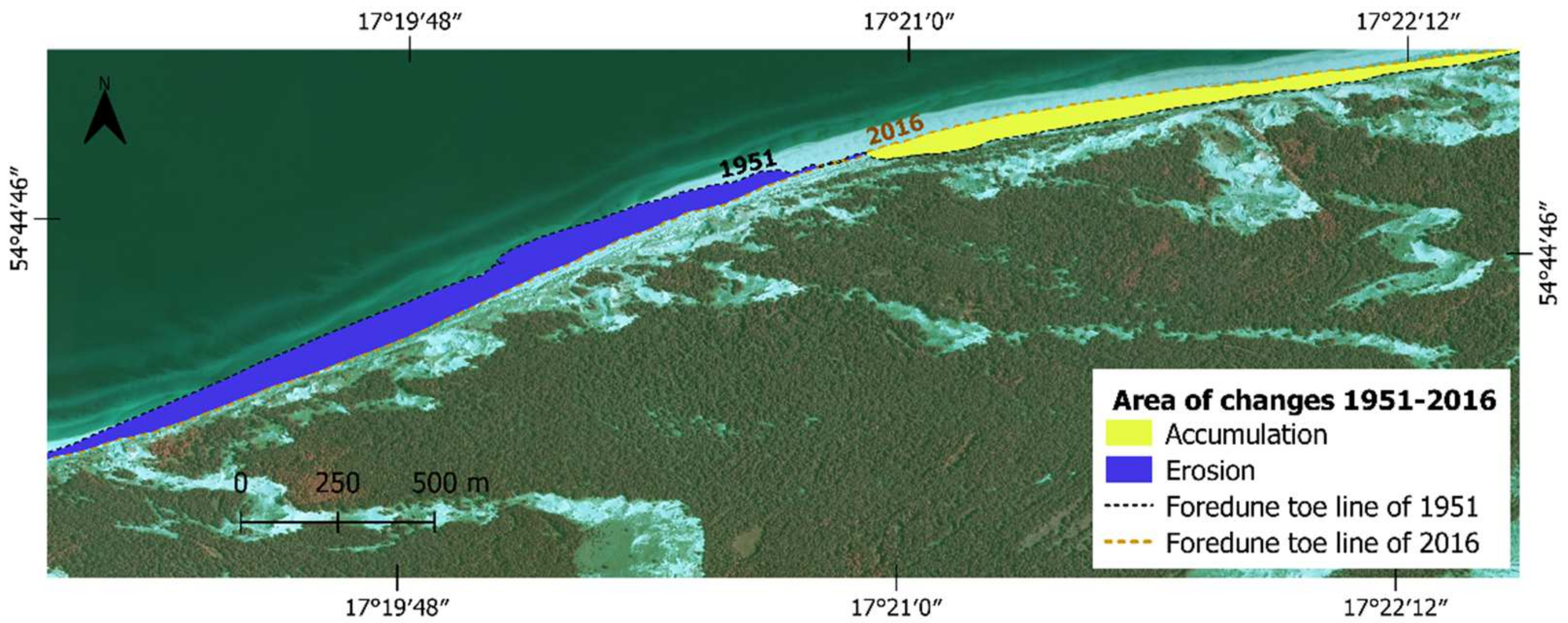
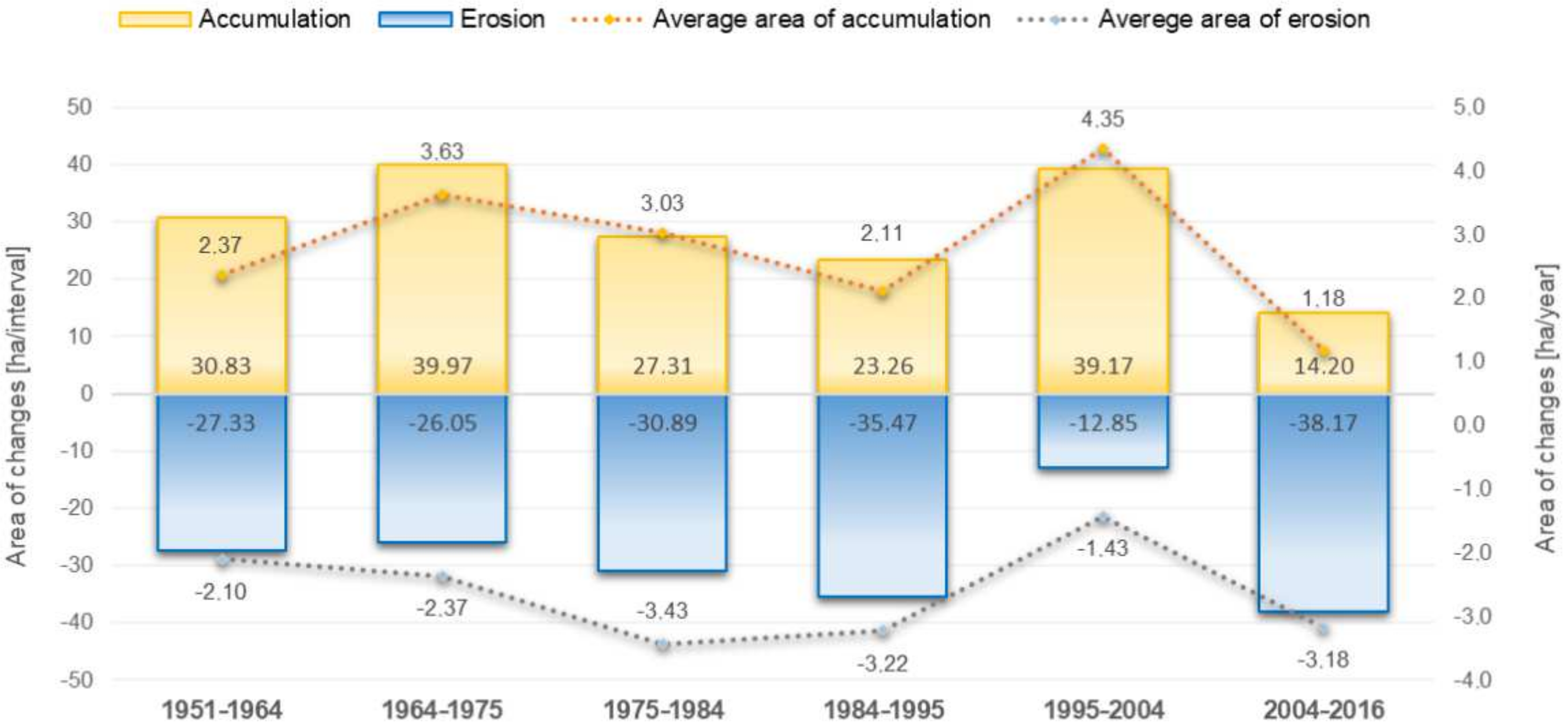
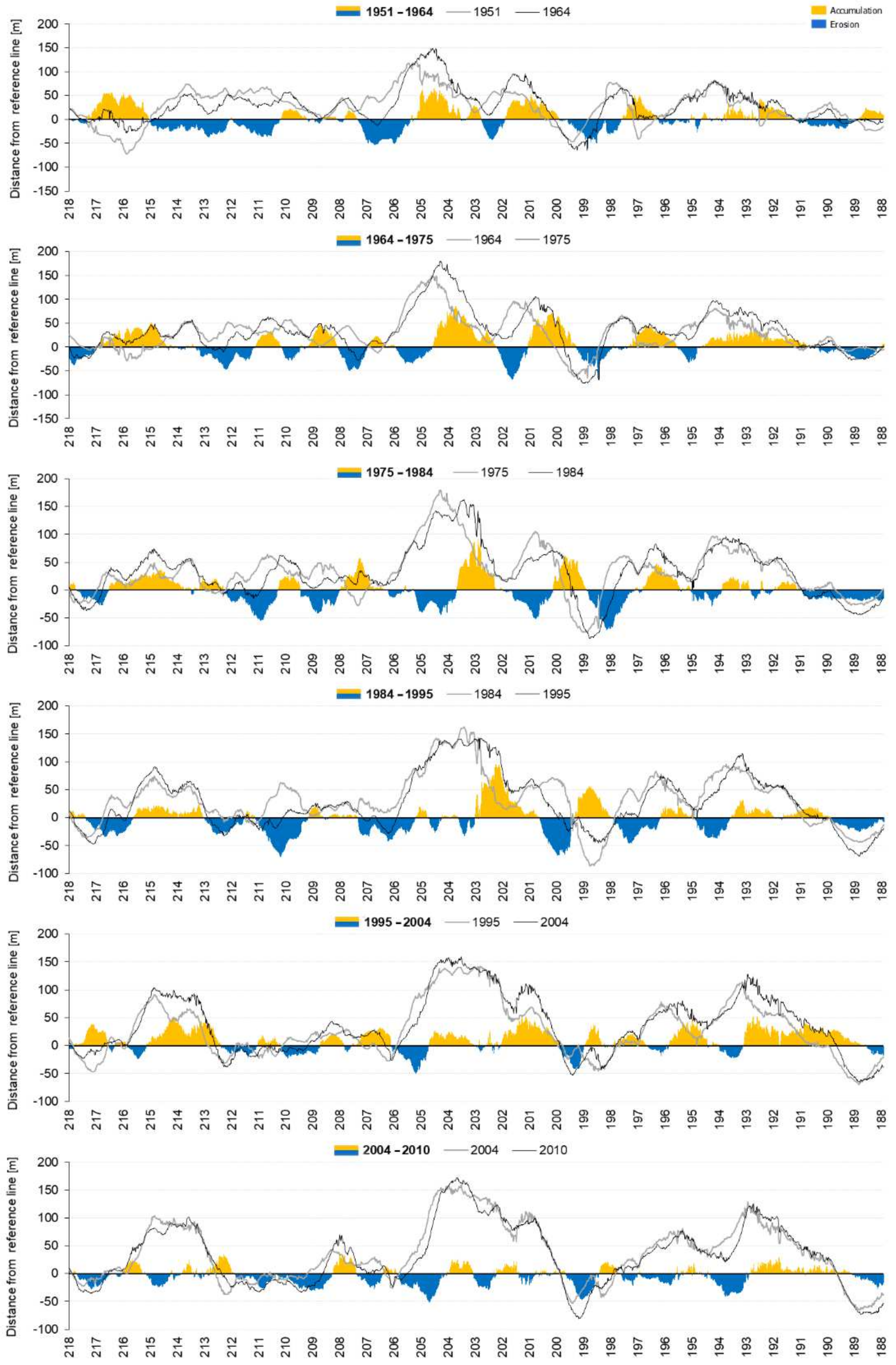

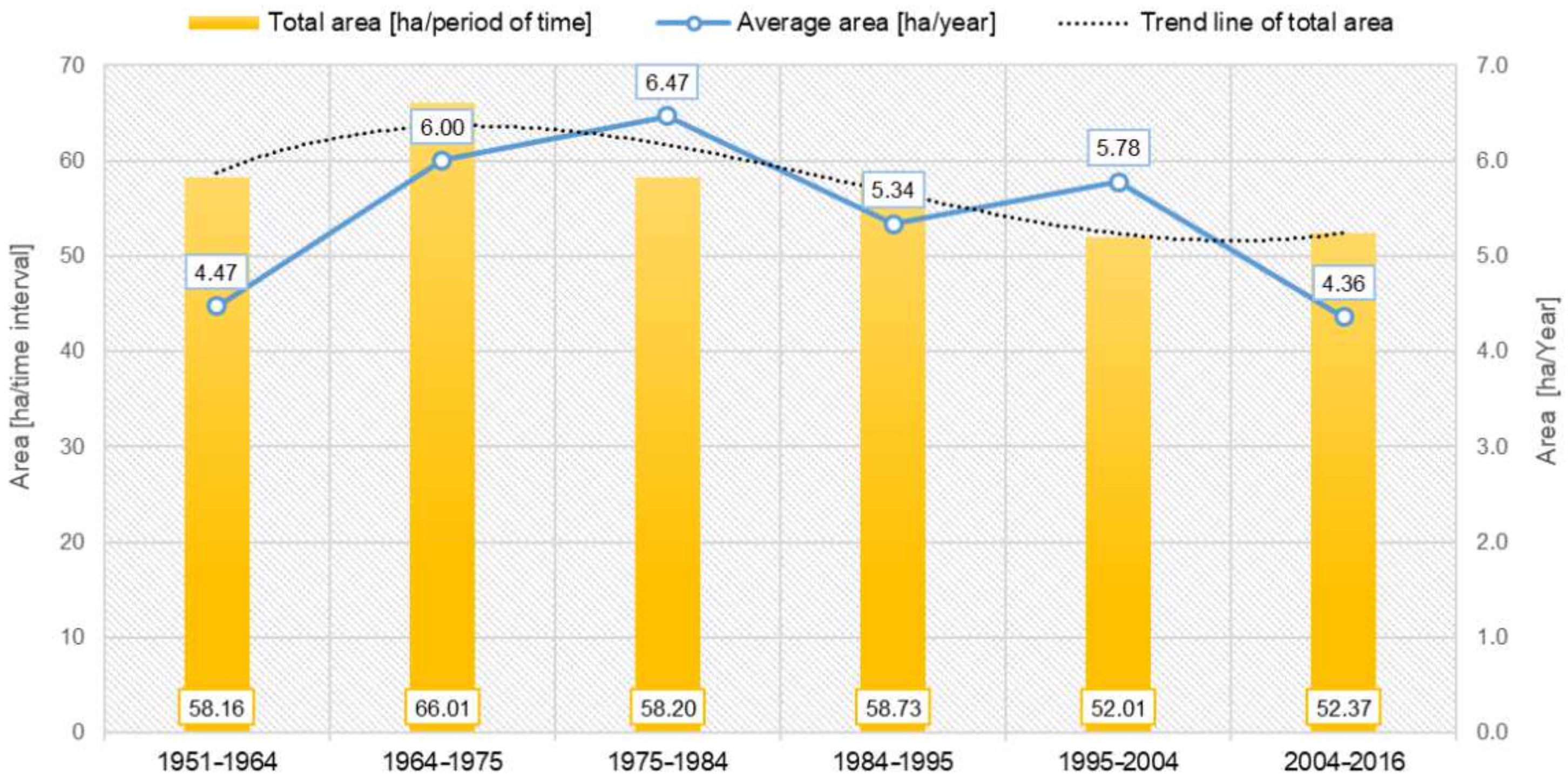

| Year | 1951 | 1964 | 1975 | 1984 | 1995 | 2004 | 2010 | 2016 |
|---|---|---|---|---|---|---|---|---|
| Camera type | RC-5 | RC-8 | RC-5/8 | RC-10 | RC-20 | RC-20 | - | - |
| Format (cm) | 18 × 18 | 23 × 23 | 23 × 23 | 23 × 23 | 23 × 23 | 23 × 23 | - | - |
| Scale | 1:25,000 | 1:23,000 | 1:29,500 | 1:25,000 | 1:26,000 | 1:26,000 | - | - |
| Pixel size (μm) | 14 | 14 | 14 | 14 | 21 | 14 | - | - |
| Source | diapositive | diapositive | diapositive | diapositive | digital | digital | digital | WMS |
| Year | 1951 | 1964 | 1975 | 1984 | 1995 | 2004 |
|---|---|---|---|---|---|---|
| Number of photos in block | 52 | 36 | 24 | 39 | 46 | 36 |
| Number of used GCPs | 45 | 59 | 61 | 69 | 61 | 59 |
| RMS X (m) | 0.36 | 0.45 | 0.36 | 0.41 | 0.11 | 0.37 |
| RMS Y (m) | 0.46 | 0.44 | 0.31 | 0.42 | 0.10 | 0.37 |
| RMS Z (m) | 0.46 | 0.45 | 0.43 | 0.36 | 0.22 | 0.28 |
| Nature of Changes | Area of Coastal Changes in Subsequent Time Series | ||||||||
|---|---|---|---|---|---|---|---|---|---|
| 1951–1964 | 1964–1975 | 1975–1984 | 1984–1995 | 1995–2004 | 2004–2016 | 2004–2010 | 2010–2016 | ||
| Accumulation | (ha) | 30.83 | 39.97 | 27.31 | 23.26 | 39.17 | 14.20 | 11.96 | 7.66 |
| (%) | 53 | 61 | 47 | 40 | 75 | 27 | 31 | 31 | |
| Erosion | (ha) | −27.33 | −26.05 | −30.89 | −35.47 | −12.85 | −38.17 | −26.94 | −17.41 |
| (%) | 47 | 39 | 53 | 60 | 25 | 73 | 69 | 69 | |
| Total area | (ha) | 58.16 | 66.01 | 58.20 | 58.73 | 52.01 | 52.37 | 38.90 | 25.07 |
| Budget | (m) | 3.5 | 13.92 | −3.59 | −12.21 | 26.32 | −23.97 | −14.98 | −9.75 |
Publisher’s Note: MDPI stays neutral with regard to jurisdictional claims in published maps and institutional affiliations. |
© 2022 by the authors. Licensee MDPI, Basel, Switzerland. This article is an open access article distributed under the terms and conditions of the Creative Commons Attribution (CC BY) license (https://creativecommons.org/licenses/by/4.0/).
Share and Cite
Michałowska, K.; Głowienka, E. Multi-Temporal Analysis of Changes of the Southern Part of the Baltic Sea Coast Using Aerial Remote Sensing Data. Remote Sens. 2022, 14, 1212. https://doi.org/10.3390/rs14051212
Michałowska K, Głowienka E. Multi-Temporal Analysis of Changes of the Southern Part of the Baltic Sea Coast Using Aerial Remote Sensing Data. Remote Sensing. 2022; 14(5):1212. https://doi.org/10.3390/rs14051212
Chicago/Turabian StyleMichałowska, Krystyna, and Ewa Głowienka. 2022. "Multi-Temporal Analysis of Changes of the Southern Part of the Baltic Sea Coast Using Aerial Remote Sensing Data" Remote Sensing 14, no. 5: 1212. https://doi.org/10.3390/rs14051212
APA StyleMichałowska, K., & Głowienka, E. (2022). Multi-Temporal Analysis of Changes of the Southern Part of the Baltic Sea Coast Using Aerial Remote Sensing Data. Remote Sensing, 14(5), 1212. https://doi.org/10.3390/rs14051212






